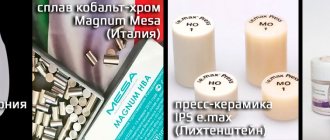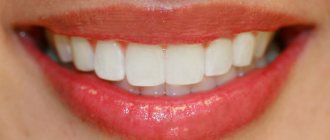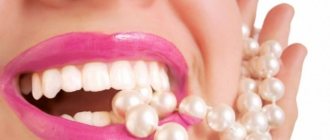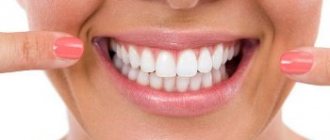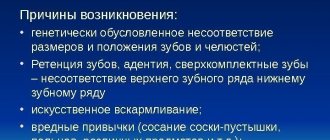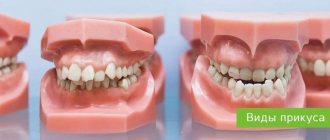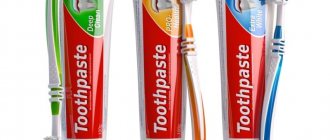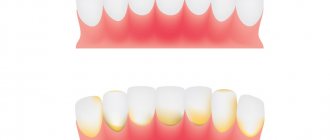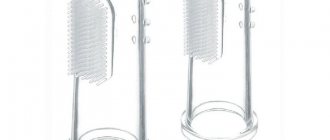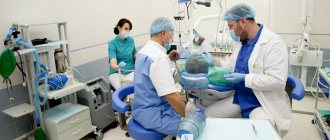Types and shapes of forceps for tooth extraction
The main surgical instruments used in dentistry are forceps. Their design differs depending on which jaw they will be used on: lower or upper.
Instruments used for the upper dentition are characterized by the fact that the axis of their cheeks and handles coincides or they are parallel. For the lower jaw, the axis of the cheeks and the axis of the handles are located either at a right angle, or this angle approaches 90 ̊.
Tooth extraction forceps also differ in other ways:
- If dental units with the crown part preserved are removed, then the design features are characterized by non-converging cheeks of the working area.
- If the roots remaining in the hole are removed, then use pliers with converging cheeks.
In order for surgery to proceed without complications, it is necessary to choose the right instrument. If the operation will be carried out in the frontal part of the upper jaw (incisors, canines), the shape of the instrument is chosen to be straight, i.e. the axes of the handles and cheeks coincide.
Forceps for removing teeth of the upper jaw of the lateral section (premolars, molars) have working parts of different sizes. To remove molars, the cheeks of the instrument are larger than for premolars. The last molars are removed using forceps with an S-shaped bend, their cheeks are located at an obtuse angle in relation to the jaws. These pliers are called bayonet pliers.
The instrumentation for removing teeth of the upper jaw has one rounded cheek and the other with a protrusion (spike). This spike is located either on the left or right side. Based on this feature, they understand which side of the dentition the instrument is intended for.
If the clinical picture is characterized by the destruction of dental tissue above the gum level, then elements with bayonet-shaped, elongated, narrowed cheeks are used to extract the root.
Dental forceps for removing teeth of the lower jaw are beak-shaped, their axes are located at right angles. Depending on which side of the dentition the pain occurs on, instruments with the appropriate cheek size are selected. The root removal tool must have converging jaws. If the dental crown is completely preserved, then the working surfaces do not converge.
In a situation where the patient has difficulty opening his mouth, removing molars from the socket becomes problematic. For the operation, horizontal nippers curved along a plane are used. They have a slightly different structure from beak-shaped forceps. Their handles and lock are located in a horizontal plane, and the cheeks bend at an angle close to 90 ̊ and are located in a vertical plane. To carry out the procedure with such instruments, movements are carried out in a horizontal plane.
Elevators
When removing a tooth using an elevator, the principle of leverage is also used. The elevator consists of:
- Working part
- Handles
- Connecting rod
All elevators are divided into straight (wide, medium, narrow - depending on the width of the working part) and angular (toward, away from you). On one side the working part is convex, on the other side there is a “groove”. During removal, the concave part (“groove”) is directed towards the root, and the convex side is directed towards the wall of the hole.
The straight elevator is used to remove the roots of single-rooted teeth or severed roots of multi-rooted teeth in both the upper and lower jaws. Angle elevators are used when removing the roots of the lower chewing teeth.
Auxiliary Tools
In severe clinical cases, when dental units are impacted or severely damaged, it is impossible to remove them using forceps. To do this, use auxiliary tools: elevator, chisel, luxator. Elevators are used in dentistry:
- W. James,
- Kuplanda,
- Cryer.
Recently, doctors have begun to replace elevators, and in some cases, dental forceps, with luxators. This choice is explained by the easy penetration of the instrument into the periodontal zone and low trauma to the alveolar bone. At the same time, the risk of postoperative complications is minimal.
Using forceps to remove teeth
Which forceps are chosen depends on:
- from the jaw on which the manipulation will be performed,
- groups of teeth (lateral, anterior),
- integrity of dental tissues,
- mouth opening width.
The type of forceps used in these cases is noted above.
The main purpose of their use is to extract the dental unit (root) from the socket. This can be done in 2 ways:
- Luxation - rocking. The method is indicated for molars and premolars with multiple roots.
- Rotation is rotation around an axis. Used to extract incisors and canines.
Operating technique using forceps:
- Local anesthesia.
- Cheek placement.
- Their advancement into the subgingival area.
- Fixation.
- Rotation or luxation.
- Extracting a dental unit from the socket.
All stages must follow strictly one after another. The success of the surgical intervention and the absence of complications depend on this.
Tool holding methods
The operation is performed with the right hand. The dentist holds the instrument so that it is comfortable. There are 2 ways:
- Hold the handles of the tool with your right hand, using the 1st, 2nd and 3rd fingers. The 4th and 5th fingers of the hand are located between the branches. If the need arises, these fingers are included in the extension of the handles. As soon as the forceps close, the 4th and 5th fingers are removed from the space between the handles of the instrument.
- One handle is held with the thumb of the right hand, and the other with 4 and 5. This method is more suitable for the upper dentition. The tips of the handles of surgical instruments rest against the palm. The handles move apart, which leads to the straightening of the 3rd finger. The closure of the handles is carried out by bending the 4th and 5th fingers. After applying the cheeks to the causative tooth, the index finger is withdrawn, and the jaws are compressed with the rest of the palm.
Removing teeth using an elevator
An elevator is usually used when the coronal part is severely damaged. To do this, take the handle of the tool in the palm of your right hand, place your index finger on the working part of the elevator, 1 cm away from the cheek. The cheek is deepened into the gap between the tooth being removed and the adjacent tooth in order to disrupt the ligamentous apparatus that holds the root in the socket, and a strong dislocation movement is performed.
After this, the cause of the pain is removed from the socket, sometimes requiring forceps. During operation, the cheek of the elevator rests against a nearby tooth. To prevent dislocation of this unit, it is necessary to firmly fix it in the socket with two fingers.
Beak-shaped forceps with converging cheeks
Beak-shaped forceps with spikes
Lecluse elevator
Bayonet pliers
031. When packing the hole, the iodoform turunda is removed:
****Answer: 2
1) on day 2
2) on day 5-7
3) on day 12-14
4) in three weeks
5) in a month
032. When removing the eighth tooth in the lower jaw, it is recommended to use a bayonet elevator in the following condition of the dentition:
****Answer: 5
1) absence of the 7th tooth
2) absence of the 6th tooth
3) III degree mobility of teeth 6 and 7
4) pathological mobility 5, 6, 7
5) the presence of stable 6 and 7
033. To remove severed roots 3.7 apply:
****Answer: 1
1) corner elevator
2) S-shaped tongs
3) bayonet elevator
4) straight tongs
5) beak-shaped forceps
034. Complications that arise during tooth extraction surgery include:
****Answer: 3
1) sinusitis
2) alveolitis
3) dislocation of an adjacent tooth
4) periostitis of the jaw
5) osteomyelitis
035. Complications that arise during tooth extraction surgery include:
****Answer: 4
1) trigeminal neuralgia
2) arthritis of the temporomandibular joint
3) mumps
4) alveolar bleeding
5) alveolitis
036.After a complex extraction of 4.8 teeth, the patient should be prescribed:
****Answer: 1
1) cold on the area of the angle of the lower jaw
2) heat compress
3) compress with Vishnevsky ointment
4) compress with Vaseline
5) physical therapy
037.The local cause of bleeding after tooth extraction is:
****Answer: 2
1) blood clotting disorder
2) soft tissue injury
3) high blood pressure
4) chronic glomerulonephritis
5) anaphylactic shock
038. The way to stop bleeding from the depths of the socket is:
****Answer: 3
1) application of potassium permanganate crystals
2) tamponade of the socket mouth
3) tight tamponade of the hole
4) suturing the wound
5) application of a hemostatic sponge
039. A common cause of bleeding after tooth extraction is:
****Answer: 3
1) acute inflammatory process in bone tissue
2) gum rupture
3) hemophilia
4) fracture of the alveolar edge
5) sinusitis
040.Possible local complication when removing teeth on the upper jaw:
****Answer: 1
1) perforation of the maxillary sinus
2) fracture of the condylar process
3) fainting
4) numbness of the lower lip
5) collapse
041. Local complication after tooth extraction surgery is:
****Answer: 2
1) tooth root fracture
2) alveolitis of the socket
3) mumps
4) anaphylactic shock
5) collapse
042. A local complication during tooth extraction surgery is:
****Answer: 1
1) fracture of the crown or root of a tooth
2) alveolitis
3) osteomyelitis of the socket
4) mumps
5) arthritis of the temporomandibular joint
043. When pushing the root into the maxillary sinus, the doctor’s erroneous action is:
****Answer: 1
1) root removal through the hole
2) applying an iodoform swab to the mouth of the hole
3) fixation of the tampon at the mouth of the hole
4) root removal in a hospital
5) oronasal test
044. Most often, displacement of teeth into the thickness of soft tissue occurs during removal of:
****Answer: 2
1) 2.4 and 1.4
And 4.8
And 4.6
And 2.8
And 2.1
045. A fracture of the tubercle of the upper jaw can occur during tooth extraction:
****Answer: 4
1) 1.1 and 2.1
And 2.3
And 4.4
And 1.8
And 4.5
046. A common cause of prolonged bleeding from the socket is:
****Answer: 1
1) acute leukemia
2) fragmentation of part of the alveoli
3) gum injury
4) acute inflammatory process
5) neuralgia
047. A sign of opening of the bottom of the maxillary sinus is:
****Answer: 4
1) bleeding from the socket of an extracted tooth
2) discharge of pus from the socket of an extracted tooth
3) nosebleeds
4) positive oral nasal test
5) soft tissue swelling
048. The local cause of bleeding from the depths of the socket is:
****Answer: 4
1) hemophilia
2) taking anticoagulants
3) hypertension
4) injury to the inferior alveolar artery
5) fainting
049. When opening the bottom of the maxillary sinus, the following should be done:
****Answer: 2
1) tight tamponade of the socket
2) cover the mouth of the hole with iodoform turunda for a period of 5-7 days
3) loose tamponade of the socket with iodoform turunda for a period of 2 days
4) suturing the perforation with a trapezoidal flap
5) conduction anesthesia
050. When pushing the root of a tooth into the maxillary sinus, you should:
****Answer: 4
1) try to remove it through the hole
2) make a tight tamponade of the hole
3) prescribe physiotherapeutic treatment
4) send the patient to the hospital
5) perform infiltration anesthesia
051. Most often, a fracture of the lower jaw occurs during tooth extraction.
****Answer: 3
1) 3.5 or 4.5
Or 3.4
Or 4.8
Or 4.2
Or 4.1
052. Perforation of the bottom of the maxillary sinus is most likely during tooth extraction:
****Answer: 3
1) 1.2, 2.2, 1.1, 2.1
2) 2.3, 1.3, 2.4, 1.4
3) 1.6, 2.6, 1.7, 2.7
4) 1.8, 2.8, 3.8, 4.8
5) 4.5, 3.5, 4.4, 3.4
053. A fracture of the lower jaw is more likely when working with tools:
****Answer: 2
1) beak-shaped forceps without spines
2) Lecluse elevator
3) beak-shaped forceps with spines
4) corner elevator “from yourself”
5) straight tongs
054. The local cause of bleeding from the socket is:
****Answer: 2
1) high blood pressure
2) fracture of the interradicular septum
3) soft tissue rupture
4) root fracture
5) sharp edges of the hole
055.In case of bleeding from the bottom of the hole, the following should be done:
****Answer: 1
1) tight tamponade of the socket with iodoform turunda
2) tamponade of the socket mouth with iodoform turunda
3) removal of the interradicular septum
4) application of a hemostatic sponge to the mouth of the socket
5) conduction anesthesia
056.For alveolitis, on the first visit you should do:
****Answer: 4
1) tight tamponade of the socket with iodoform turunda
2) curettage of the hole
3) incision along the transitional fold
4) remove the disintegrated clot and loosely introduce iodoform turunda into the hole
5) local anesthesia
057. To stop bleeding from the walls of the hole:
****Answer: 5
1) tamponade with iodoform turunda
2) prescription of antihypertensive therapy
3) blood transfusion
4) urgent hospitalization of the patient
5) compression of the bleeding area of the bone
058. To stop bleeding in case of soft tissue damage, use:
****Answer: 2
1) blood transfusion
2) suturing the wound
3) general hemostatic therapy
4) anticoagulants intravenously
5) local anesthesia
059. When opening the bottom of the maxillary sinus, the following is carried out:
****Answer: 2
1) rinsing with an antiseptic solution
2) suturing with a flap
3) tight tamponade of the hole
4) application of antibiotics
5) curettage of the maxillary sinus
060In case of a root fracture, the doctor’s wrong action is:
****Answer: 4
1) complete root removal
2) leaving a root fragment in the hole
3) removal of granulation tissue
4) smoothing the sharp edge of the bone
5) repeat surgery after 7-10 days
061. Local long-term complications after tooth extraction include:
****Answer: 4
1) hypertensive crisis
2) dislocation of the temporomandibular joint
3) fainting
4) osteomyelitis of the socket
5) collapse
062. When pushing the tooth root into the posterior parts of the hyoid region during the removal of 3.8 and 4.8, the following is performed:
****Answer: 4
1) dissection of soft tissue above the root
2) detachment of the mucoperiosteal flap
3) suturing the tooth socket
4) hospitalization of the patient
5) local anesthesia
063. Complications that arise during the removal of the eighth tooth of the upper jaw include:
****Answer: 1
1) fracture of the tubercle of the upper jaw
2) neuritis of the nasopalatine nerve
3) osteomyelitis of the socket
4) sinusitis
5) arthritis
064. In case of gum rupture during tooth extraction surgery, the following is indicated:
****Answer: 2
1) wound packing
2) suturing the gum
3) treatment of the wound surface with 1% iodine solution
4) application with epithelializing agents
5) diathermocoagulation
065. Dislocation of the lower jaw is possible during tooth extraction:
****Answer: 4
1) 2.4, 1.4
2) 1.3, 2.3
3) 4.1, 3,1
4) 4.7, 3.7
5) 2.1, 1.1
Using Luxators
Thanks to the luxator, it is possible to remove an impacted or severely damaged tooth with minimal stress for the doctor and the patient. The procedure is easier than using an elevator and safer.
The handle of the tool is held with the right hand. The index finger is placed slightly above the cheek of the instrument. The working part under the gum is not inserted directly, but at a slight angle. The movements are of an oscillatory (swinging) nature, disintegrating. This helps to separate the periodontal fibers, expand the alveoli and eliminate the vacuum in this area. All this contributes to the trouble-free removal of the tooth from the socket using forceps, and if it has only one root, forceps are not needed at all.
Modern dentistry has everything necessary to carry out the removal procedure efficiently and painlessly for any degree of destruction, even if only a small part of the root remains. There is no need to be afraid of surgery. Clinical observations and patient reviews show that with correctly selected instruments and highly qualified physicians, postoperative complications are reduced to zero.
Author: Natalya Stagurskaya, dentist, especially for Karies.pro
Drill
Sawing teeth using a drill is an alternative to chiseling and hammering out teeth. Both straight and turbine handpieces are used.
A straight tip (ball-shaped bur) is used to remove bone tissue that is overhanging or interfering with tooth extraction. A turbine tip (fissure burs) is most often used for sawing a tooth into several parts: separating the crown from the roots, separating the roots in order to remove them later separately.
It is necessary to remind you that when operating the drill, you must use water cooling.
We advise you to read: Tactics regarding primary teeth in adult patients
